The Mastacembelidae are a family of fishes, known as the spiny eels. The Mastacembelids are part of the Order Synbranchiformes, the swamp eels, which are part of the Actinopterygii.
Notacanthidae, the deep-sea spiny eels, are a family of fishes found worldwide below 125 m (410 ft), and as deep as 3,500 m (11,500 ft).
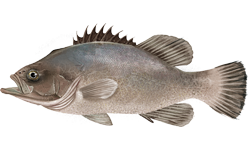
The wreckfish are a small group of ray-finned fish in the genus Polyprion, belonging to the monotypic family Polyprionidae in the order Acropomatiformes.
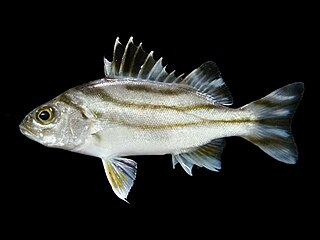
Grunters or tigerperches are ray-finned fishes in the family Terapontidae. This family is part of the superfamily Percoidea of the order Perciformes.

Trichogaster is a genus of gouramis native to South Asia from Pakistan to Myanmar. It is the only genus in the monotypic subfamily Trichogastrinae as set out in the 5th Edition of Fishes of the World, although that book states that there are two genera, the other being Colisa which is treated as a synonym of Trichogaster by Fishbase and the Catalog of Fishes. Fishbase also places the genus in the Luciocephalinae. Species of this genus are very popular in the aquarium trade.
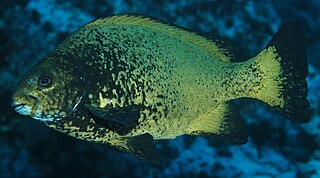
The sea chubs, also known as rudderfish and pilot fish and in Hawaiian as enenue or nenue, are a family, Kyphosidae, of fishes in the order Perciformes native to the Atlantic, Indian and Pacific Oceans usually close to shore in marine waters.

Dichistius is a genus of perciform fishes, the galjoen fishes, native to the Atlantic coast of southern Africa and the Indian Ocean coast of southern Africa. Growing to lengths of 80 cm (31 in) and 35 cm (14 in), both known species are popular commercial and game fishes.

Oplegnathus is currently the sole recognized genus in the knifejaw family (Oplegnathidae) of marine perciform fishes. The largest, the Cape knifejaw, can reach a maximum length around 90 cm (35 in). Knifejaws have teeth fused into a parrot-like beak in adulthood. They feed on barnacles and mollusks, and are fished commercially. They are native to the Indian and Pacific Oceans.

Percilia is a genus of perch-like fish in the monogeneric family Perciliidae.

Glaucosoma, the pearl perches, are perciform fishes native to the Indian Ocean waters around Australia and the western Pacific Ocean. This genus is currently the only one assigned to the family Glaucosomatidae.

The Chlopsidae, or false morays, are a family of marine ray-finned fishes belonging to the order Anguilliformes, the eels. The eels in this family arefound in coral reefs worldwide. As their name suggests, they somewhat resemble moray eels in appearance. However, they are smaller than true morays, ranging from 11 to 42 cm in length.
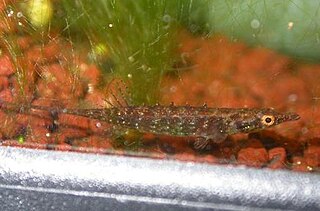
Indostomus is a genus of small fishes native to slow moving or stagnant freshwater habitats in Indochina. It is the sole genus of the monogeneric family Indostomidae, Long considered to be sticklebacks, within the order Gasterosteiformes, modern analyses place the Indostomids within the order Synbranchiformes, related to the spiny eels and swamp eels.
Notacanthus is a genus of spiny eels in the family Notacanthidae.
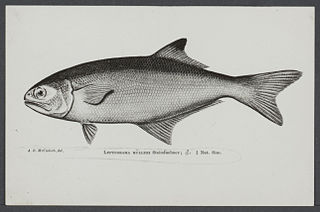
Leptobrama is a genus of ray-finned fish in the order Carangiformes found in the Pacific Ocean. This genus is the only member of the family Leptobramidae.
Lipogenys gillii, the blackfin tapirfish, is a species of spiny eel in the family Notacanthidae, the only member of its genus. It is a benthic deep-sea fish occurring along the eastern coast of North America and in the southwestern Pacific near Australia at depths from 400 to 2,000 m.

Lateolabrax is a genus of commercially important fishes known as the Asian seabasses. It is the only genus in the family Lateolabracidae. This genus is native to the coastal waters of the western Pacific Ocean. This genus has also been included in family Moronidae and may be nested within the Polyprionidae.

Brotula is a genus of cusk-eels. It is the only genus in the subfamily Brotulinae.
Brotulotaenia is a genus of cusk-eels. It is the only genus in the subfamily Brotulotaeniinae.

Easchmeyer nexus is a species of marine ray-finned fish; it is the only species in the monotypic genus Eschmeyer and monogeneric family Eschmeyeridae. This fish is only known from the Pacific Ocean, near Fiji.
Gymnelinae is a subfamily of marine ray-finned fish belonging to the family Zoarcidae, the eelpouts. Most species are found in the North Pacific Ocean but one genus is cosmopolitan, and another is endemic to the Southern Ocean.














